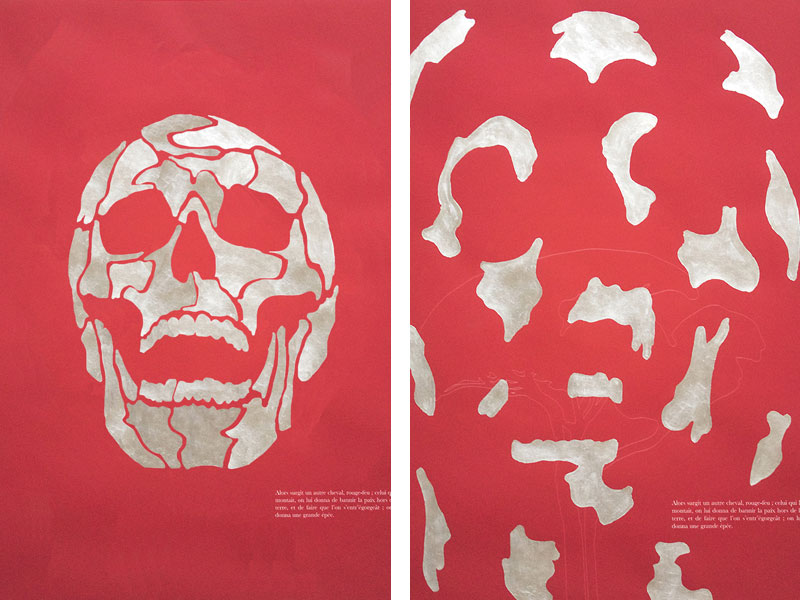
” Nature holds the key to our aesthetic, intellectual, cognitive and even spiritual satisfaction “
E. O. Wilson
The growing needs of resources are pushing men to conquer new territories in defiance of fauna and flora, rare and fragile. This unrestrained quest creates international conflicts that affect local populations, which are usually the first victims and the most affected. Nowadays, Humanity faces the first consequences of his insatiable lust for power and wealth. The acceleration of global warming, as pollution of water and soil, and lack of vital resources certainly lead the world toward a global chaos. By analogy, we find this disaster in the Bible, more specifically in the Apocalypse of Saint John. The Four Horsemen of the Apocalypse is a prophetic creation described in the last book of the New Testament of the Bible (Saint John the Apostle at 6:1-8). The chapter tells of a book or scroll in God’s right hand that is sealed with seven seals. The Lamb of God, or Lion of Judah, opens the first four of the seven seals, which summons four beings that ride out on white, red, black, and pale horses. The four riders are seen as symbolizing Conquest, War, Famine, and Death, respectively.

The Four Horsemen of the Apocalypse by Albrecht Dürer - 1497
The Four Horsemen of the Apocalype
The Cavaliers series by TES-TED is a modern illustration of Saint John’s prophecy. The Four Horsemen, morbid and apathetic characters, are represented here by four skulls each broken into pieces and placed on different colors. The White Horseman or the Conquest, here symbolizes the quest that firms fiercely race for oil in Arctic waters. Judean Bitumen is used to represent the skull parts, and is applied on a white background inspired from pure floe. The Red Horseman or the War symbolizes the numerous conflicts faced by every continent and especially Africa, where uranium, silver or diamond extractions are the starting point of bloody civil wars. The skull is represented here by silver flakes on a red background like a bloodstained earth. The Black Horseman or Famine symbolizes overfishing destroying fragile ecosystems such as barrier reefs that form the essential element for life underwater. Here the skull is illustrated by copper chips, copper that is found in cookware, on an ocean blue background. The Pale Horseman or Death symbolizes the pollution of watercourses like the Amazon, particularly from gold panning. The skull is here represented by pure gold chips on a green background, green as the Amazon rainforest. Split the skulls symbolize the idea of an Apocalypse, but the further humanity destroys his environment, the more chips are getting closer to each other, reforming the skulls that announce an imminent and inevitable chaos.

Gilding technique inspired from the past
The gold beater must know how to mix pure gold with other precious metals to obtain rich and complex nuances, expose it to the fire of the forge, the steel of the rolling mill and the hammers, then, in a breath, place each individual leaf between sheets of tissue paper. When the alloy is reduced to such a thin and delicate leaf that it is hardly able to support its own weight, it then becomes light. A radiant, joyful and eternal light.

© Gilles Bertrand

Maison Dauvet : Over 300 years of excellence
True to a technique inherited from antiquity, enhanced during Renaissance, gold beating represents an invaluable part of our cultural and historical heritage. For over 180 years, you will find Dauvet gold leaves in Palaces and National Museums, among the most passionate gilders and framers, in the kitchens of the world’s greatest chefs, in the workshops of exceptional craftsmen: bookbinders, illuminators, calligraphers, glass makers, potters…
Today Dauvet’s team combines 300 years of experience, and continue to produce the finest gold leaves produced in Europe. The company uses 999.9‰ pure gold which is refined in France or in Switzerland. The leaves are seventy five thousand times thinner than the original gold bar!
Every mould is manually opened by a qualified staff whose dexterity and attention to detail are essential in order to manipulate the gold leaves.

Maison Dauvet

© Gilles Bertrand
The Cavaliers series :
4





